Mingqing Xiao
A Self-Ensemble Inspired Approach for Effective Training of Binary-Weight Spiking Neural Networks
Aug 18, 2025Abstract:Spiking Neural Networks (SNNs) are a promising approach to low-power applications on neuromorphic hardware due to their energy efficiency. However, training SNNs is challenging because of the non-differentiable spike generation function. To address this issue, the commonly used approach is to adopt the backpropagation through time framework, while assigning the gradient of the non-differentiable function with some surrogates. Similarly, Binary Neural Networks (BNNs) also face the non-differentiability problem and rely on approximating gradients. However, the deep relationship between these two fields and how their training techniques can benefit each other has not been systematically researched. Furthermore, training binary-weight SNNs is even more difficult. In this work, we present a novel perspective on the dynamics of SNNs and their close connection to BNNs through an analysis of the backpropagation process. We demonstrate that training a feedforward SNN can be viewed as training a self-ensemble of a binary-activation neural network with noise injection. Drawing from this new understanding of SNN dynamics, we introduce the Self-Ensemble Inspired training method for (Binary-Weight) SNNs (SEI-BWSNN), which achieves high-performance results with low latency even for the case of the 1-bit weights. Specifically, we leverage a structure of multiple shortcuts and a knowledge distillation-based training technique to improve the training of (binary-weight) SNNs. Notably, by binarizing FFN layers in a Transformer architecture, our approach achieves 82.52% accuracy on ImageNet with only 2 time steps, indicating the effectiveness of our methodology and the potential of binary-weight SNNs.
Online Pseudo-Zeroth-Order Training of Neuromorphic Spiking Neural Networks
Jul 17, 2024



Abstract:Brain-inspired neuromorphic computing with spiking neural networks (SNNs) is a promising energy-efficient computational approach. However, successfully training SNNs in a more biologically plausible and neuromorphic-hardware-friendly way is still challenging. Most recent methods leverage spatial and temporal backpropagation (BP), not adhering to neuromorphic properties. Despite the efforts of some online training methods, tackling spatial credit assignments by alternatives with comparable performance as spatial BP remains a significant problem. In this work, we propose a novel method, online pseudo-zeroth-order (OPZO) training. Our method only requires a single forward propagation with noise injection and direct top-down signals for spatial credit assignment, avoiding spatial BP's problem of symmetric weights and separate phases for layer-by-layer forward-backward propagation. OPZO solves the large variance problem of zeroth-order methods by the pseudo-zeroth-order formulation and momentum feedback connections, while having more guarantees than random feedback. Combining online training, OPZO can pave paths to on-chip SNN training. Experiments on neuromorphic and static datasets with fully connected and convolutional networks demonstrate the effectiveness of OPZO with similar performance compared with spatial BP, as well as estimated low training costs.
Temporal Spiking Neural Networks with Synaptic Delay for Graph Reasoning
May 27, 2024



Abstract:Spiking neural networks (SNNs) are investigated as biologically inspired models of neural computation, distinguished by their computational capability and energy efficiency due to precise spiking times and sparse spikes with event-driven computation. A significant question is how SNNs can emulate human-like graph-based reasoning of concepts and relations, especially leveraging the temporal domain optimally. This paper reveals that SNNs, when amalgamated with synaptic delay and temporal coding, are proficient in executing (knowledge) graph reasoning. It is elucidated that spiking time can function as an additional dimension to encode relation properties via a neural-generalized path formulation. Empirical results highlight the efficacy of temporal delay in relation processing and showcase exemplary performance in diverse graph reasoning tasks. The spiking model is theoretically estimated to achieve $20\times$ energy savings compared to non-spiking counterparts, deepening insights into the capabilities and potential of biologically inspired SNNs for efficient reasoning. The code is available at https://github.com/pkuxmq/GRSNN.
Hebbian Learning based Orthogonal Projection for Continual Learning of Spiking Neural Networks
Feb 19, 2024

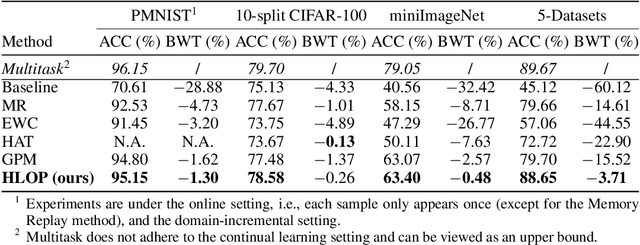

Abstract:Neuromorphic computing with spiking neural networks is promising for energy-efficient artificial intelligence (AI) applications. However, different from humans who continually learn different tasks in a lifetime, neural network models suffer from catastrophic forgetting. How could neuronal operations solve this problem is an important question for AI and neuroscience. Many previous studies draw inspiration from observed neuroscience phenomena and propose episodic replay or synaptic metaplasticity, but they are not guaranteed to explicitly preserve knowledge for neuron populations. Other works focus on machine learning methods with more mathematical grounding, e.g., orthogonal projection on high dimensional spaces, but there is no neural correspondence for neuromorphic computing. In this work, we develop a new method with neuronal operations based on lateral connections and Hebbian learning, which can protect knowledge by projecting activity traces of neurons into an orthogonal subspace so that synaptic weight update will not interfere with old tasks. We show that Hebbian and anti-Hebbian learning on recurrent lateral connections can effectively extract the principal subspace of neural activities and enable orthogonal projection. This provides new insights into how neural circuits and Hebbian learning can help continual learning, and also how the concept of orthogonal projection can be realized in neuronal systems. Our method is also flexible to utilize arbitrary training methods based on presynaptic activities/traces. Experiments show that our method consistently solves forgetting for spiking neural networks with nearly zero forgetting under various supervised training methods with different error propagation approaches, and outperforms previous approaches under various settings. Our method can pave a solid path for building continual neuromorphic computing systems.
Towards Memory- and Time-Efficient Backpropagation for Training Spiking Neural Networks
Mar 07, 2023



Abstract:Spiking Neural Networks (SNNs) are promising energy-efficient models for neuromorphic computing. For training the non-differentiable SNN models, the backpropagation through time (BPTT) with surrogate gradients (SG) method has achieved high performance. However, this method suffers from considerable memory cost and training time during training. In this paper, we propose the Spatial Learning Through Time (SLTT) method that can achieve high performance while greatly improving training efficiency compared with BPTT. First, we show that the backpropagation of SNNs through the temporal domain contributes just a little to the final calculated gradients. Thus, we propose to ignore the unimportant routes in the computational graph during backpropagation. The proposed method reduces the number of scalar multiplications and achieves a small memory occupation that is independent of the total time steps. Furthermore, we propose a variant of SLTT, called SLTT-K, that allows backpropagation only at K time steps, then the required number of scalar multiplications is further reduced and is independent of the total time steps. Experiments on both static and neuromorphic datasets demonstrate superior training efficiency and performance of our SLTT. In particular, our method achieves state-of-the-art accuracy on ImageNet, while the memory cost and training time are reduced by more than 70% and 50%, respectively, compared with BPTT.
SPIDE: A Purely Spike-based Method for Training Feedback Spiking Neural Networks
Feb 01, 2023
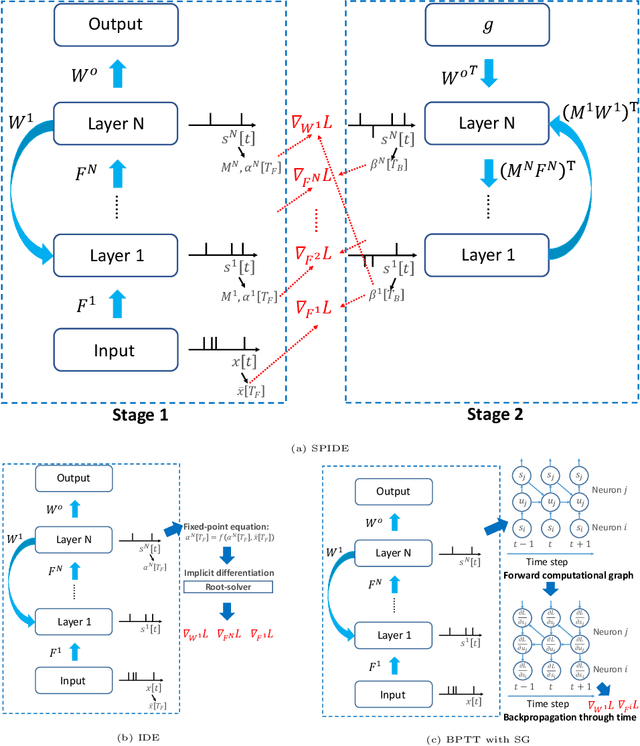
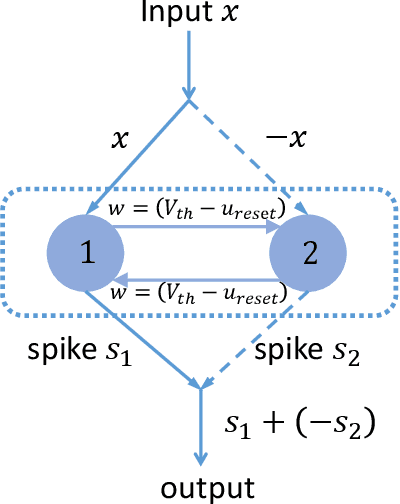

Abstract:Spiking neural networks (SNNs) with event-based computation are promising brain-inspired models for energy-efficient applications on neuromorphic hardware. However, most supervised SNN training methods, such as conversion from artificial neural networks or direct training with surrogate gradients, require complex computation rather than spike-based operations of spiking neurons during training. In this paper, we study spike-based implicit differentiation on the equilibrium state (SPIDE) that extends the recently proposed training method, implicit differentiation on the equilibrium state (IDE), for supervised learning with purely spike-based computation, which demonstrates the potential for energy-efficient training of SNNs. Specifically, we introduce ternary spiking neuron couples and prove that implicit differentiation can be solved by spikes based on this design, so the whole training procedure, including both forward and backward passes, is made as event-driven spike computation, and weights are updated locally with two-stage average firing rates. Then we propose to modify the reset membrane potential to reduce the approximation error of spikes. With these key components, we can train SNNs with flexible structures in a small number of time steps and with firing sparsity during training, and the theoretical estimation of energy costs demonstrates the potential for high efficiency. Meanwhile, experiments show that even with these constraints, our trained models can still achieve competitive results on MNIST, CIFAR-10, CIFAR-100, and CIFAR10-DVS. Our code is available at https://github.com/pkuxmq/SPIDE-FSNN.
Online Training Through Time for Spiking Neural Networks
Oct 09, 2022

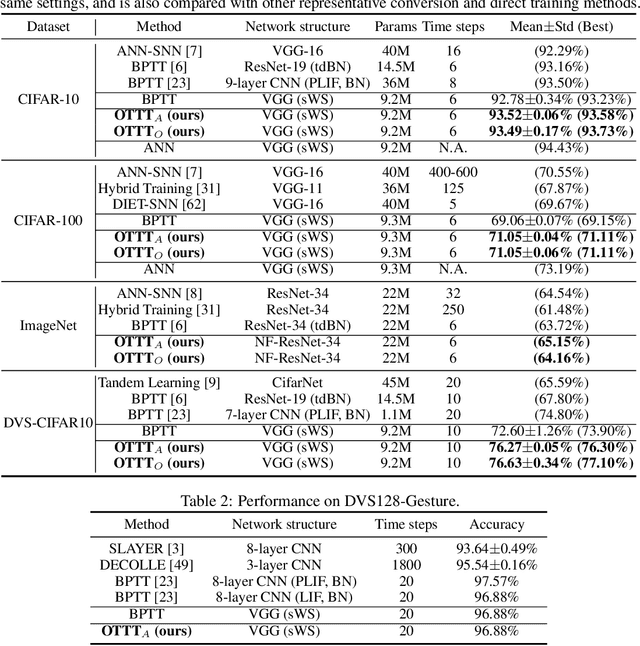
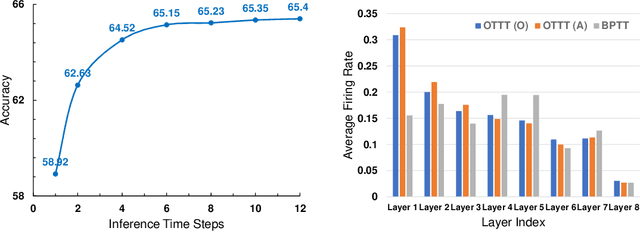
Abstract:Spiking neural networks (SNNs) are promising brain-inspired energy-efficient models. Recent progress in training methods has enabled successful deep SNNs on large-scale tasks with low latency. Particularly, backpropagation through time (BPTT) with surrogate gradients (SG) is popularly used to achieve high performance in a very small number of time steps. However, it is at the cost of large memory consumption for training, lack of theoretical clarity for optimization, and inconsistency with the online property of biological learning and rules on neuromorphic hardware. Other works connect spike representations of SNNs with equivalent artificial neural network formulation and train SNNs by gradients from equivalent mappings to ensure descent directions. But they fail to achieve low latency and are also not online. In this work, we propose online training through time (OTTT) for SNNs, which is derived from BPTT to enable forward-in-time learning by tracking presynaptic activities and leveraging instantaneous loss and gradients. Meanwhile, we theoretically analyze and prove that gradients of OTTT can provide a similar descent direction for optimization as gradients based on spike representations under both feedforward and recurrent conditions. OTTT only requires constant training memory costs agnostic to time steps, avoiding the significant memory costs of BPTT for GPU training. Furthermore, the update rule of OTTT is in the form of three-factor Hebbian learning, which could pave a path for online on-chip learning. With OTTT, it is the first time that two mainstream supervised SNN training methods, BPTT with SG and spike representation-based training, are connected, and meanwhile in a biologically plausible form. Experiments on CIFAR-10, CIFAR-100, ImageNet, and CIFAR10-DVS demonstrate the superior performance of our method on large-scale static and neuromorphic datasets in small time steps.
Invertible Rescaling Network and Its Extensions
Oct 09, 2022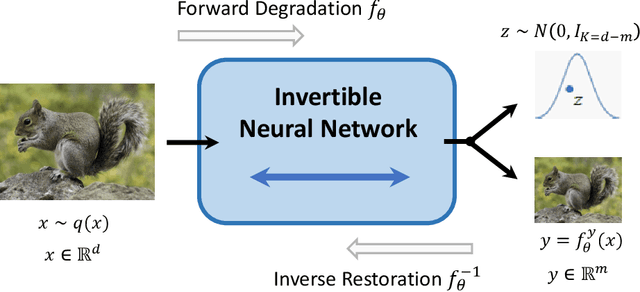
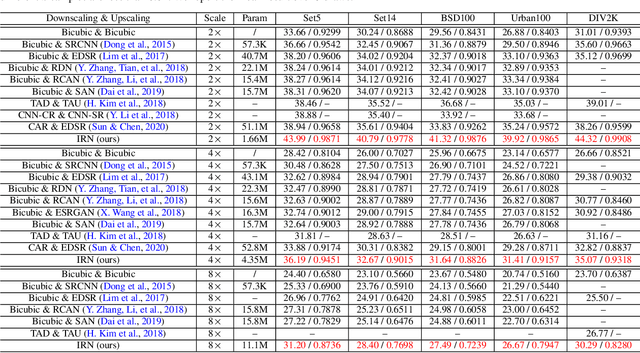


Abstract:Image rescaling is a commonly used bidirectional operation, which first downscales high-resolution images to fit various display screens or to be storage- and bandwidth-friendly, and afterward upscales the corresponding low-resolution images to recover the original resolution or the details in the zoom-in images. However, the non-injective downscaling mapping discards high-frequency contents, leading to the ill-posed problem for the inverse restoration task. This can be abstracted as a general image degradation-restoration problem with information loss. In this work, we propose a novel invertible framework to handle this general problem, which models the bidirectional degradation and restoration from a new perspective, i.e. invertible bijective transformation. The invertibility enables the framework to model the information loss of pre-degradation in the form of distribution, which could mitigate the ill-posed problem during post-restoration. To be specific, we develop invertible models to generate valid degraded images and meanwhile transform the distribution of lost contents to the fixed distribution of a latent variable during the forward degradation. Then restoration is made tractable by applying the inverse transformation on the generated degraded image together with a randomly-drawn latent variable. We start from image rescaling and instantiate the model as Invertible Rescaling Network (IRN), which can be easily extended to the similar decolorization-colorization task. We further propose to combine the invertible framework with existing degradation methods such as image compression for wider applications. Experimental results demonstrate the significant improvement of our model over existing methods in terms of both quantitative and qualitative evaluations of upscaling and colorizing reconstruction from downscaled and decolorized images, and rate-distortion of image compression.
Training High-Performance Low-Latency Spiking Neural Networks by Differentiation on Spike Representation
May 01, 2022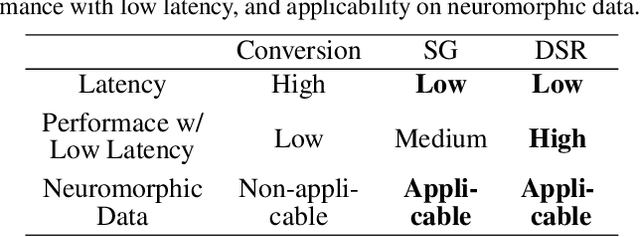

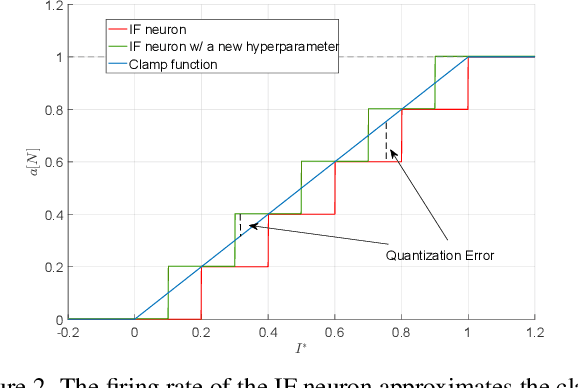
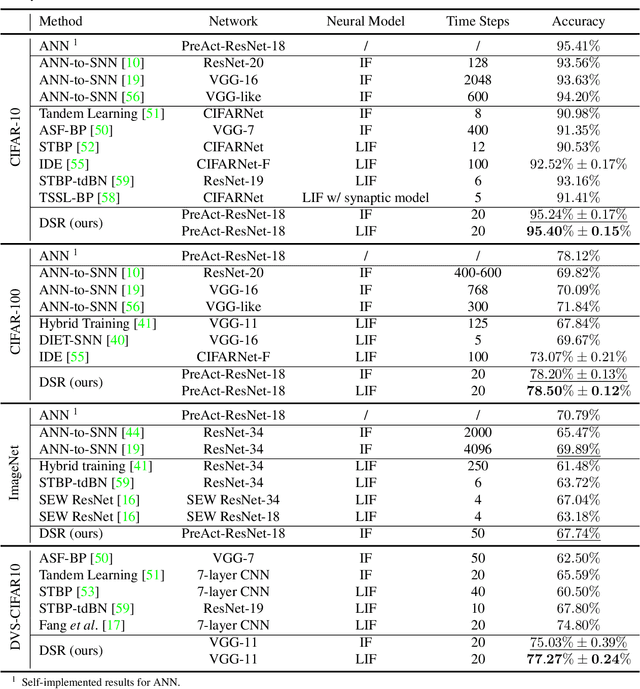
Abstract:Spiking Neural Network (SNN) is a promising energy-efficient AI model when implemented on neuromorphic hardware. However, it is a challenge to efficiently train SNNs due to their non-differentiability. Most existing methods either suffer from high latency (i.e., long simulation time steps), or cannot achieve as high performance as Artificial Neural Networks (ANNs). In this paper, we propose the Differentiation on Spike Representation (DSR) method, which could achieve high performance that is competitive to ANNs yet with low latency. First, we encode the spike trains into spike representation using (weighted) firing rate coding. Based on the spike representation, we systematically derive that the spiking dynamics with common neural models can be represented as some sub-differentiable mapping. With this viewpoint, our proposed DSR method trains SNNs through gradients of the mapping and avoids the common non-differentiability problem in SNN training. Then we analyze the error when representing the specific mapping with the forward computation of the SNN. To reduce such error, we propose to train the spike threshold in each layer, and to introduce a new hyperparameter for the neural models. With these components, the DSR method can achieve state-of-the-art SNN performance with low latency on both static and neuromorphic datasets, including CIFAR-10, CIFAR-100, ImageNet, and DVS-CIFAR10.
Training Feedback Spiking Neural Networks by Implicit Differentiation on the Equilibrium State
Sep 29, 2021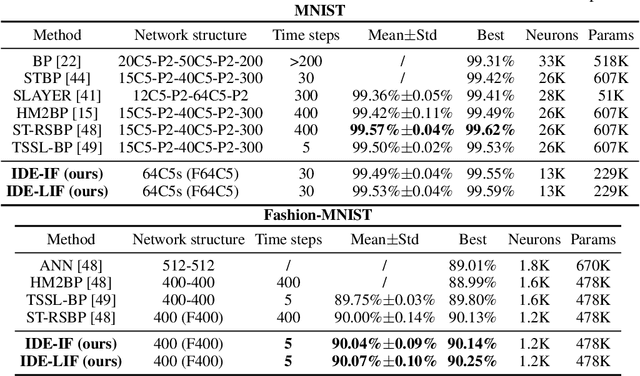


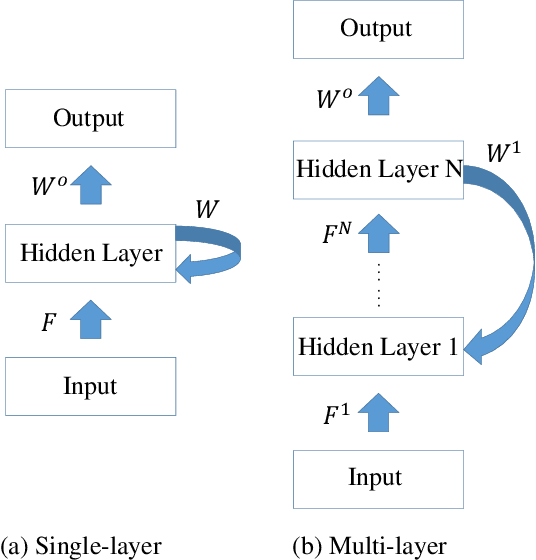
Abstract:Spiking neural networks (SNNs) are brain-inspired models that enable energy-efficient implementation on neuromorphic hardware. However, the supervised training of SNNs remains a hard problem due to the discontinuity of the spiking neuron model. Most existing methods imitate the backpropagation framework and feedforward architectures for artificial neural networks, and use surrogate derivatives or compute gradients with respect to the spiking time to deal with the problem. These approaches either accumulate approximation errors or only propagate information limitedly through existing spikes, and usually require information propagation along time steps with large memory costs and biological implausibility. In this work, we consider feedback spiking neural networks, which are more brain-like, and propose a novel training method that does not rely on the exact reverse of the forward computation. First, we show that the average firing rates of SNNs with feedback connections would gradually evolve to an equilibrium state along time, which follows a fixed-point equation. Then by viewing the forward computation of feedback SNNs as a black-box solver for this equation, and leveraging the implicit differentiation on the equation, we can compute the gradient for parameters without considering the exact forward procedure. In this way, the forward and backward procedures are decoupled and therefore the problem of non-differentiable spiking functions is avoided. We also briefly discuss the biological plausibility of implicit differentiation, which only requires computing another equilibrium. Extensive experiments on MNIST, Fashion-MNIST, N-MNIST, CIFAR-10, and CIFAR-100 demonstrate the superior performance of our method for feedback models with fewer neurons and parameters in a small number of time steps. Our code is avaiable at https://github.com/pkuxmq/IDE-FSNN.
 Add to Chrome
Add to Chrome Add to Firefox
Add to Firefox Add to Edge
Add to Edge